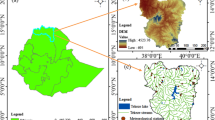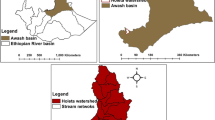Abstract
Erosion is a major issue due to the global availability of land cover change and inadequate land use throughout the world. The topmost fertile soil is predominantly removed via erosion, which lowers both the productivity of the land and the storage capacity of reservoirs. This consequence has a large influence on the global economy; as a result, soil conservation practice is currently being used as a crucial solution to this issue. It is challenging, particularly for developing nations, to carry out soil conservation in a large basin without a significant investment. Therefore, it is essential to determine the most susceptible regions to erosion and implement the necessary remedial measures for those areas in order to lower the investment cost and enhance the efficiency of the work. In this study, erosion-prone areas are identified using the SWAT model. This model has a high level of acceptance globally for managing, allocating, and predicting water resources. However, there is some uncertainty with the model, and this uncertainty may come from the measured data, model structure, or input data. Therefore, extensive sensitivity analysis, uncertainty prediction, and model calibration are required to achieve good simulation results. Model calibration, sensitivity analysis, and prediction of uncertainty are conducted with SUFI-2, ParaSol, GLUE, and PSO, which are integrated with SWAT-CUP software. For this study, SUFI-2 algorithm gives the best simulation results out of the four algorithms, with R2 values of 0.76 and 0.85 under streamflow and R2 values of 0.8 and 0.66 under sediment for calibration and validation, respectively. From the final simulation of 34 subbasins, five subbasins were identified as the most sensitive areas for erosion; these subbasins are 1, 3, 5, 14, and 17, and they have a mean annual sediment yield of 23 tons/ha/year.











Similar content being viewed by others
Data availability
Data and material will be given when a request has been made.
References
Ackermann WC (1976) Soil and water conservation. EOS Trans Am Geophys Union 57(10):708–711. https://doi.org/10.1029/EO057i010p00708
Arnold JG, Moriasi DN, Gassman PW, Abbaspour KC, White MJ, Srinivasan R, Santhi C, Harmel RD, Van Griensven A, Van Liew MW, Kannan N, Jha MK, Harmel D, Member A, Van Liew MW, Arnold J-FG (2012) Swat: model use, calibration, and validation. Trans ASABE 55(4):1491–1508
Benisi Ghadim H, Salarijazi M, Ahmadianfar I, Heydari M, Zhang T (2020) Developing a sediment rating curve model using the curve slope. Polish J Environ Stud 29(2):1151–1159. https://doi.org/10.15244/pjoes/103470
Bhati DS, Dubey SK, Sharma D (2021) Application of satellite-based and observed precipitation datasets for hydrological simulation in the upper mahi river basin of Rajasthan India. Sustainability. https://doi.org/10.3390/su13147560
Blanco H, Lal R (2008). (PDF) Humberto Blanco Canqui Rattan Lal auth Principles of Soil Conservation and Management Springer Netherlands 2010 | Trần Thảo - Academia.edu.
Blanco-Canqui H, Lal R (2010). Principles of soil conservation and management. In: Principles of soil conservation and management. https://doi.org/10.1007/978-1-4020-8709-7
Chiang LC, Liao CJ, Lu CM, Wang YC (2021). Applicability of modified SWAT model (SWAT-Twn) on simulation of watershed sediment yields under different land use/cover scenarios in Taiwan. Environmental Monitoring and Assessment, 193(8). https://doi.org/10.1007/s10661-021-09283-9
Dong L, Xiong L, Lall U, Wang J (2015) The effects of land use change and precipitation change on direct runoff in Wei River watershed China. Water Sci Technol 71(2):289–295. https://doi.org/10.2166/wst.2014.510
Dutta S, Sen D (2018) Application of SWAT model for predicting soil erosion and sediment yield. Sustain Water Res Manag 4(3):447–468. https://doi.org/10.1007/s40899-017-0127-2
European Environment Agency, & United Nation Enviromental Programme. (2013). Down to Earth: Soil degradation and sustainable development in Europe (Issue 16). http://www.worldcat.org/title/down-to-earth-soil-degradation-and-sustainable-development-in-europe-a-challenge-for-the-21st-century/oclc/45959241
Fentaw F, Hailu D, Nigussie A, Melesse AM (2018) Climate change impact on the hydrology of Tekeze Basin, Ethiopia: projection of rainfall-runoff for future water resources planning. Water Conserv Sci Eng 3(4):267–278. https://doi.org/10.1007/s41101-018-0057-3
Feyissa Negewo T, Kumar Sarma A (2021) Spatial and temporal variability evaluation of sediment yield and sub-basins/hydrologic response units prioritization on Genale Basin Ethiopia. J Hydrol 603:127190. https://doi.org/10.1016/j.jhydrol.2021.127190
Ghezelsofloo AA, Eftekhari M, Mahmodizadeh S, Akbari M (2022). Simulation of runoff from Atrak River Basin Iran using SWAT model ( A case study ) Simulation of runoff from Atrak River Basin Iran using SWAT model ( A case study ). https://doi.org/10.25252/SE/2022/222697
Gray JR, Simões FJM (2008) Estimating sediment discharge. Sediment Eng 74:1067–1088. https://doi.org/10.1061/9780784408148.apd
Guse B, Reusser DE, Fohrer N (2014) How to improve the representation of hydrological processes in SWAT for a lowland catchment - temporal analysis of parameter sensitivity and model performance. Hydrol Process 28(4):2651–2670. https://doi.org/10.1002/hyp.9777
Hajabbasi MA, Jalalian A, Karimzadeh HR (1997) Deforestation effects on soil physical and chemical properties, lordegan, iran. Plant Soil 190(2):301–308. https://doi.org/10.1023/A:1004243702208
Healy RW, Essaid HI (2012) VS2DI: model use, calibration, and validation. Trans ASABE 55(4):1249–1260. https://doi.org/10.13031/2013.42256
Hughes DA (2006) Comparison of satellite rainfall data with observations from gauging station networks. J Hydrol 327(3–4):399–410. https://doi.org/10.1016/j.jhydrol.2005.11.041
Issaka S, Ashraf MA (2017) Impact of soil erosion and degradation on water quality: a review. Geol Ecol Landsc 1(1):1–11. https://doi.org/10.1080/24749508.2017.1301053
Javanmard S, Yatagai A, Nodzu MI, Bodaghjamali J, Kawamoto H (2010) Comparing high-resolution gridded precipitation data with satellite rainfall estimates of TRMM-3B42 over Iran. Adv Geosci 25:119–125. https://doi.org/10.5194/adgeo-25-119-2010
Khalid K, Ali MF, Rahman NFA, Mispan MR, Haron SH, Othman Z, Bachok MF (2016) Sensitivity Analysis in Watershed Model Using SUFI-2 Algorithm. Procedia Eng 162:441–447. https://doi.org/10.1016/j.proeng.2016.11.086
Kindu M, Schneider T, Teketay D, Knoke T (2015) Drivers of land use/land cover changes in Munessa-Shashemene landscape of the south-central highlands of Ethiopia. Environ Monit Assess. https://doi.org/10.1007/s10661-015-4671-7
Klik A, Eitzinger J (2010) Impact of climate change on soil erosion and the efficiency of soil conservation practices in Austria. J Agric Sci 148(5):529–541. https://doi.org/10.1017/S0021859610000158
Kumar S, Merwade V (2009) Impact of watershed subdivision and soil data resolution on swat model calibration and parameter uncertainty. J Am Water Resour Assoc 45(5):1179–1196. https://doi.org/10.1111/j.1752-1688.2009.00353.x
Marutani T, Kasai MIO, Reid LM, Trustrum NA (1999). Influence of storm-related sediment storage on the sediment delivery from tributary catchments in the upper Waipaoa river, New Zealand. 896, 881–896
Mehan S, Neupane RP, Kumar S (2017) Coupling of SUFI 2 and SWAT for improving the simulation of streamflow in an agricultural watershed of South Dakota. Hydrol Curr Res. https://doi.org/10.4172/2157-7587.1000280
Montgomery DR (2007) Soil erosion and agricultural sustainability. Proc Natl Acad Sci USA 104(33):13268–13272. https://doi.org/10.1073/pnas.0611508104
Mosbahi M, Benabdallah S, Boussema MR (2013) Assessment of soil erosion risk using SWAT model. Arab J Geosci 6(10):4011–4019. https://doi.org/10.1007/s12517-012-0658-7
Najmaddin PM, Whelan MJ, Balzter H (2017) Application of satellite-based precipitation estimates to rainfall-runoff modelling in a data-scarce semi-arid catchment. Climate. https://doi.org/10.3390/cli5020032
Owolabi ST, Madi K, Kalumba AM (2021) Comparative evaluation of spatio-temporal attributes of precipitation and streamflow in Buffalo and Tyume Catchments, Eastern Cape, South Africa. Environ Dev Sustain 23(3):4236–4251. https://doi.org/10.1007/s10668-020-00769-z
Poesen J (2018) Soil erosion in the Anthropocene: research needs. Earth Surf Proc Land 43(1):64–84. https://doi.org/10.1002/esp.4250
Reed MS, Buenemann M, Atlhopheng J, Akhtar-Schuster M, Bachmann F, Bastin G, Bigas H, Chanda R, Dougill AJ, Essahli W, Evely AC, Fleskens L, Geeson N, Glass JH, Hessel R, Holden J, Ioris AAR, Kruger B, Liniger HP, Verzandvoort S (2011) Cross-scale monitoring and assessment of land degradation and sustainable land management: a methodological framework for knowledge management. Land Degrad Dev 22(2):261–271. https://doi.org/10.1002/ldr.1087
Sadeghi SHR, Mizuyama T (2007) Applicability of the modified universal soil loss equation for prediction of sediment yield in Khanmirza watershed. Iran Hydrol Sci J 52(5):1068–1075. https://doi.org/10.1623/hysj.52.5.1068
Sinnathamby S, Douglas-Mankin KR, Craige C (2017) Field-scale calibration of crop-yield parameters in the soil and water assessment tool (SWAT). Agric Water Manag 180:61–69. https://doi.org/10.1016/j.agwat.2016.10.024
Stamey WL, Smith RM (1964) A conservation definition of erosion tolerance. Soil Sci 97(3):183–186. https://doi.org/10.1097/00010694-196403000-00006
Tang X, Zhang J, Wang G, Jin J, Liu C, Liu Y, He R, Bao Z (2021) Uncertainty analysis of swat modeling in the lancang river basin using four different algorithms. Water 13(3):1–21. https://doi.org/10.3390/w13030341
Tesfay S, Teferi M (2017) Assessment of fish post-harvest losses in Tekeze dam and Lake Hashenge fishery associations: Northern Ethiopia. Agri Food Secur 6(1):1–12. https://doi.org/10.1186/s40066-016-0081-5
Tesfaye S, Taye G, Birhane E, van der Zee SE (2019a) Observed and model simulated twenty-first century hydro-climatic change of Northern Ethiopia. J Hydrol Reg Stud 22(2018):100595. https://doi.org/10.1016/j.ejrh.2019.100595
Tesfaye S, Taye G, Birhane E, van der Zee SE (2019b) Observed and model simulated twenty-first century hydro-climatic change of Northern Ethiopia. J Hydrol Reg Stud 22:100595. https://doi.org/10.1016/j.ejrh.2019.100595
Tibebe D, Bewket W (2011) Surface runoff and soil erosion estimation using the SWAT model in the Keleta Watershed Ethiopia. Land Degrad Devel 22(6):551–564. https://doi.org/10.1002/ldr.1034
Tsai W, Humphrey JAC, Cornet I, Levy AV (1981) Experimental measurement of accelerated erosion in a slurry pot tester. Wear 68(3):289–303. https://doi.org/10.1016/0043-1648(81)90178-2
Tuo Y, Duan Z, Disse M, Chiogna G (2016) Evaluation of precipitation input for SWAT modeling in Alpine catchment: A case study in the Adige river basin (Italy). Sci Total Environ 573:66–82. https://doi.org/10.1016/j.scitotenv.2016.08.034
Uniyal B, Jha MK, Verma AK, Anebagilu PK (2020) Identification of critical areas and evaluation of best management practices using SWAT for sustainable watershed management. Sci Total Environ 744:140737. https://doi.org/10.1016/j.scitotenv.2020.140737
Vanmaercke M, Poesen J, Maetens W, de Vente J, Verstraeten G (2011) Sediment yield as a desertification risk indicator. Sci Total Environ 409(9):1715–1725. https://doi.org/10.1016/j.scitotenv.2011.01.034
Welde K (2016) Identification and prioritization of subwatersheds for land and water management in Tekeze dam watershed, Northern Ethiopia. Int Soil Water Conserv Res 4(1):30–38. https://doi.org/10.1016/j.iswcr.2016.02.006
White KL, Chaubey I (2005) Sensitivity analysis, calibration, and validations for a multisite and multivariable SWAT model. J Am Water Resour Assoc 41(5):1077–1089. https://doi.org/10.1111/j.1752-1688.2005.tb03786.x
Woldesenbet TA, Elagib NA, Ribbe L, Heinrich J (2017) Hydrological responses to land use/cover changes in the source region of the Upper Blue Nile Basin, Ethiopia. Sci Total Environ 575:724–741. https://doi.org/10.1016/j.scitotenv.2016.09.124
Woznicki SA, Nejadhashemi AP (2013) Spatial and temporal variabilities of sediment delivery ratio. Water Resour Manage 27(7):2483–2499. https://doi.org/10.1007/s11269-013-0298-z
Yang D, Kanae S, Oki T, Koike T, Musiake K (2003) Global potential soil erosion with reference to land use and climate changes. Hydrol Process 17(14):2913–2928. https://doi.org/10.1002/hyp.1441
Yuemei H, Xiaoqin Z, Jianguo S, Jina N (2008) Conduction between left superior pulmonary vein and left atria and atria fibrillation under cervical vagal trunk stimulation. Colombia Medica 39(3):227–234. https://doi.org/10.1234/590
Zealand N (1981) Sediment delivery ratio as used in the computation of watershed sediment Author ( s ): Mou Jinze and Meng Qingmei Source : Journal of Hydrology ( New Zealand ) , 1981 , Vol . 20 , No . 1 ,In: Christchurch symposium : " Erosion and sediment transport in Pacif. 20(1)
Acknowledgements
The authors wish to thank all who assisted in conducting this work.
Author information
Authors and Affiliations
Corresponding author
Ethics declarations
Conflict of interest
There is no conflict of interest by the authors.
Additional information
Editorial responsibility: Samareh Mirkia.
Rights and permissions
Springer Nature or its licensor (e.g. a society or other partner) holds exclusive rights to this article under a publishing agreement with the author(s) or other rightsholder(s); author self-archiving of the accepted manuscript version of this article is solely governed by the terms of such publishing agreement and applicable law.
About this article
Cite this article
Hailu, M.B., Mishra, S.K., Jain, S.K. et al. Identifying and prioritizing erosion-prone areas at the subbasin level of the Tekeze watershed, Ethiopia. Int. J. Environ. Sci. Technol. 21, 387–398 (2024). https://doi.org/10.1007/s13762-023-04938-1
Received:
Revised:
Accepted:
Published:
Issue Date:
DOI: https://doi.org/10.1007/s13762-023-04938-1




